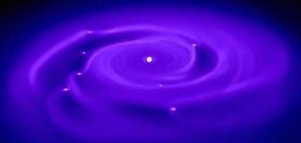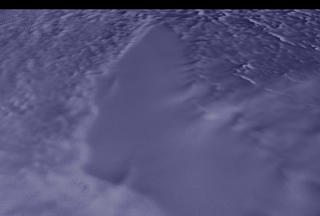

SEARCH FOR EXTRASOLAR PLANETS
One of the basic questions when looking for extra terrestrial life is - How many planets are there outside of our own solar system? Is our sun unique with its oddball family of worlds orbiting around it or do other stars also have orbiting planets?
 In the past decade astronomers have been searching for planets around other stars. So far they have found over 100. Most of these new worlds are gas giants similar or larger to Jupiter, but as techniques improve in this new science smaller planets are likely to be discovered. All of this means that even in our own galaxy there are likely to be millions of different worlds orbiting their stars and some of them could well contain life.
In the past decade astronomers have been searching for planets around other stars. So far they have found over 100. Most of these new worlds are gas giants similar or larger to Jupiter, but as techniques improve in this new science smaller planets are likely to be discovered. All of this means that even in our own galaxy there are likely to be millions of different worlds orbiting their stars and some of them could well contain life.
ASTROBIOLOGY
This is another relatively new branch of science but it is advancing rapidly. Astrobiology seeks to understand the origins and evolution of life on earth and whether life exists elsewhere.
One area of research covers the search for life in earth's most hostile environments. We know that life flourishes in the rainforests and temperate zones of earth but these types of environments aren't found on any other planets in our solar system. What would be exciting is the discovery of life at the bottom of frozen lakes in Antarctica or organisms living deep in the earth's rocky crust because these environments can be found on other planets.
 Recently some new residents were discovered in Idaho. They consume hydrogen, breathe carbon dioxide and belch methane, so there goes the neighbourhood. They are tiny organisms called Methanogens and they live in the earth's crust 660ft below the (Idaho) surface.Their discovery is extremely significant because they survive without the need for sunlight or oxygen. They may be exactly the type of life we should look for when we send probes to Mars.
Recently some new residents were discovered in Idaho. They consume hydrogen, breathe carbon dioxide and belch methane, so there goes the neighbourhood. They are tiny organisms called Methanogens and they live in the earth's crust 660ft below the (Idaho) surface.Their discovery is extremely significant because they survive without the need for sunlight or oxygen. They may be exactly the type of life we should look for when we send probes to Mars.
Read more about life on Mars
 Apart from Mars another world that has caught scientists attention is Europa, one of Jupiter's moons. When the Galileo probe visited Jupiter and its attendant Galilean moons, Europa was thought to be a frozen ball of rock and ice. However pictures taken by the probe clearly revealed a series of cracks and fissures across the moon's surface. There is only one other place in the solar system that has this appearance, the frozen arctic seas on earth. It appears that deep below the icy surface Europa has a system of giant oceans. The composition of these oceans is unknown but there is a fair chance they support life. How do we know that life could survive below massive permanent layers of ice in oceans with no light reaching them? Because in similar conditions here on earth astrobiologists have also found life.
Apart from Mars another world that has caught scientists attention is Europa, one of Jupiter's moons. When the Galileo probe visited Jupiter and its attendant Galilean moons, Europa was thought to be a frozen ball of rock and ice. However pictures taken by the probe clearly revealed a series of cracks and fissures across the moon's surface. There is only one other place in the solar system that has this appearance, the frozen arctic seas on earth. It appears that deep below the icy surface Europa has a system of giant oceans. The composition of these oceans is unknown but there is a fair chance they support life. How do we know that life could survive below massive permanent layers of ice in oceans with no light reaching them? Because in similar conditions here on earth astrobiologists have also found life.
 Lake Vostok is a huge lake that lies under ice that is 10 times as deep as the Empire State Building is tall. By drilling over 11,000 metres down samples were taken of freshwater ice and microbes were found living in these samples. So the saying "Where there's water there's life" has been taken as far as we can push it on earth. The belief that liquid water may exist on Europa and was once prevalent on the Martian surface gives astrobiologists hope that the discovery of alien life may not be too far away.
Lake Vostok is a huge lake that lies under ice that is 10 times as deep as the Empire State Building is tall. By drilling over 11,000 metres down samples were taken of freshwater ice and microbes were found living in these samples. So the saying "Where there's water there's life" has been taken as far as we can push it on earth. The belief that liquid water may exist on Europa and was once prevalent on the Martian surface gives astrobiologists hope that the discovery of alien life may not be too far away.
RELATED PAGES AT ASTROCENTRAL
Search for life on Mars
Search for life on Europa
